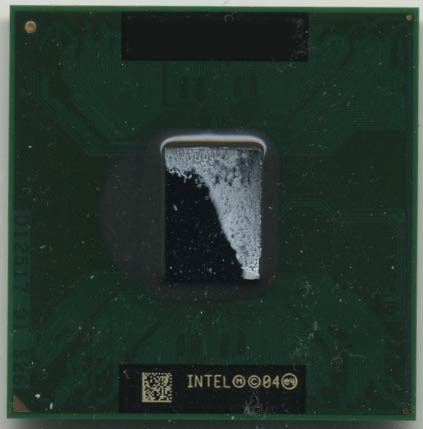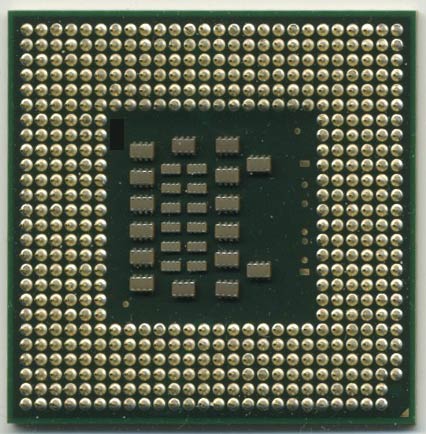Intel Yonah Performance Preview - Part I: The Exclusive First Look at Yonah
by Anand Lal Shimpi on November 30, 2005 2:50 AM EST- Posted in
- CPUs
Intel, oh Intel, how uninteresting your processors have been to us for so long now. Where have the days of the Northwood gone? Prescott brought us a minor bump in clock speed, minor increases in performance, and more importantly - major increases in power bills. But if any company can go down the wrong path for five years and still come out on top, it’s Intel. So starting next year, we’ll start seeing a new Intel. A more power conscious Intel and to kick it all off will be Intel’s first Earth-friendly dual core processor: Yonah.
As the successor to the current Pentium M (Dothan) and the predecessor to next year’s Conroe, Merom and Woodcrest cores, Yonah is a very important chip. As a mobile processor Yonah will bring dual core to thin and light notebooks, basically anywhere you’d find a Pentium M, you’ll now be able to find two Pentium Ms. The implications for mobile performance are huge, as multitasking on notebooks has rarely been all that great of an experience. At the same time, Yonah is so much more than just a dual core mobile processor - it’s a predictor of the performance of Intel’s next-generation desktop micro-architecture. Sure, it won’t have all of the architectural bells and whistles that we’ll see when Conroe debuts at the end of next year, but it’ll have many and that makes it a reference point.
The problem with the Pentium M architecture has been that although it’s traditionally done well at office tasks and obviously in the power consumption department, it has lagged behind the Pentium 4 and Athlon 64 when it comes to FP intensive applications such as video encoding, and to a lesser degree, 3D gaming. With Yonah, Intel has promised to address those performance issues, and even more so with their next-generation micro-architecture later next year. But we tend to want to see things for ourselves, and Yonah will at least give us an indication of how things have improved since Dothan, and whether or not Intel is on the right track to replacing the Pentium 4.
By now we’ve hopefully stressed the importance of Yonah, and there’s just one more detail to mention - we have one.
The Platform - Yet Another Socket
While the launch of Yonah still won’t be until January of next year, we’ve had a chip for the past month, unfortunately, we haven’t had a motherboard to stick it in. We finally got one two days ago, which is why you’re seeing this article now, instead of more pictures of our Yonah posing alongside the Xbox 360. The problem is that Intel seems to have changed sockets once more, meaning that Yonah is not backwards compatible with the original Pentium M socket.

If you’ll remember back to the introduction of the Pentium M, Intel introduced a brand new socket for the processor: Socket-479. Back then, the desktop Pentium 4 still used the pin-based Socket-478, so the different pin-out was a bit of a pain to deal with as we all wanted to be able to stick Pentium Ms in our Pentium 4 motherboards.

The Yonah socket is still a 479-pin interface, however the pin-out has been changed once more, and of course Yonah won’t even physically fit into any current Pentium M motherboards. Instead, you’ll need a brand new motherboard with a brand new chipset. So if you invested in any of the handful of desktop Pentium M motherboards that were released over the past year, you’re unfortunately out of luck.

Yonah (left) vs. Dothan (right) - Note the different pin-out
What’s this about a new chipset? Well, it’s not exactly a new chipset, rather it’s Intel’s mobile 945 chipset - the mobile version of the desktop chipset we’ve had for quite some time now. The platform we’re testing on in particular uses Intel’s 945G chipset, with integrated graphics, but of course we aren’t too interested in integrated graphics performance so we’ll be using the PCIe x16 slot on the board.
While we can’t tell you who makes the motherboard we’re testing with, the important thing to note is that it is a desktop motherboard made specifically for Yonah. It’s got a single PCIe x16 slot, meaning you don’t have to rely on integrated graphics, and all of the bells and whistles you’d expect from a desktop motherboard; this could very well be the heart of your next system.
We’ve been hearing that Pentium M based desktops will become a lot more common next year, and this motherboard is definitely an indication of that.










135 Comments
View All Comments
lee1026 - Wednesday, November 30, 2005 - link
They still can't beat the A64 3800+? sad, intel, sad.Pythias - Wednesday, November 30, 2005 - link
Graphs I looked at, it appeared the two were neck and neck. And the yonah cosumes less power.Darth Farter - Wednesday, November 30, 2005 - link
well, what about the RAM power consumption difference... is this censored or something?Yonah's 1.8V DDR2 ram opposed to the Athlon X2's 2.6V DDR ram
if the reviewer really measured "Total System Power" this will factor in... the same reason why the Pentium M is still king of Battery Life on mobile platforms...
When Socket M2 arrives Q2 2006 it could prove better for performance and less for power requirements again.... and without being transitioned to 65nm process yet.
anyway, this is not cpu isolated and therefore I'd suggest just mentioning it includes the worse DDR power consumption (apples to apples) before the community blames the cpu only like in the comments here.
(btw, if there would be any way to isolate the cpu power usage only without motherboard and ram I would really like to know. (I thought I saw something like that on overclockers.com a few moths back.)
anyway could my point matter on the graphs on last page Anand?
coldpower27 - Wednesday, November 30, 2005 - link
This is the price you pay for having an On Die Memory Controller, Intel can adopt new memory technologies quciker then AMD can as they don't need another revison of a CPU plus a Socket change due to the memory controller, this is the price AMD paid to get the added performance, and reduced power cosumption of having the memory cnotroller on Die and not needing a Northbridge. This is AMD's choice and they have to live with the consequences of this choice.Zebo - Friday, December 2, 2005 - link
Nevermind they did change thier socket.coldpower27 - Sunday, December 11, 2005 - link
I think they wanted to make sure that only the i945M Chipset series is compatible with the Dual Core Yonah and not run the risk of people sticking these into older i915M and the currently available desktop Pentium M boards.This is a move for profit of course, as Intel wants to sell their new i945M chipsets as a Centrino bundle with Yonah.
nserra - Wednesday, November 30, 2005 - link
AMD 64 2.0Ghz at .13 at full load does 68WAMD 64 2.0Ghz at .09 at full load does 43W
AMD 64 2.0Ghz at .65 at full load maybe ~27W
AMD 64 2.0Ghz at .13 at idle does 19W
AMD 64 2.0Ghz at .09 at idle does 13W
AMD 64 2.0Ghz at .65 at idle maybe ~9W
tayhimself - Wednesday, November 30, 2005 - link
90nm 3800x2 is around 68 W. Take out 8 or so for the northbridge. There is no 130nm x2 IIRCnserra - Wednesday, November 30, 2005 - link
Sorry I forgot to mention, its single core amd processors not dual.Viditor - Wednesday, November 30, 2005 - link
Someone who doesn't know the difference between TDP and power usage...